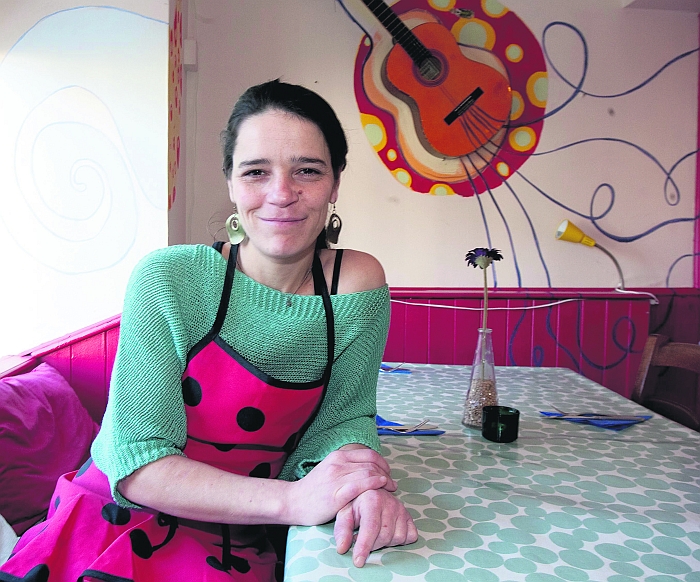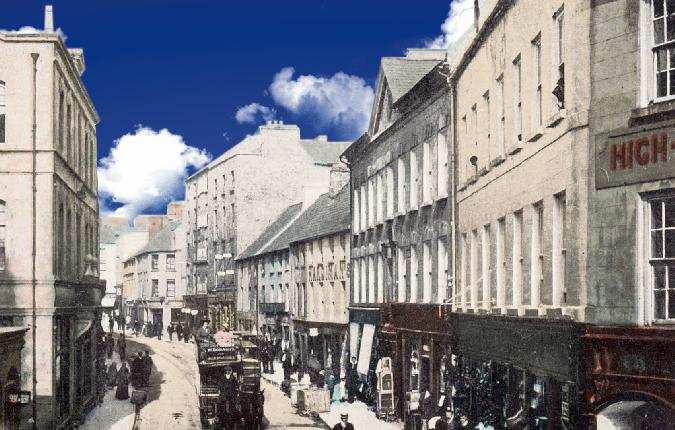Archive News
Home cooking with a difference puts restaurant on culinary map

Date Published: 31-Jan-2013
Amaya Fernandez has always had a profound relationship with food. The owner of Lunares, the colourful Spanish restaurant and tapas bar which adds an uncharacteristic splash of colour to Woodquay, first fell in love with food through her father Julio in their home in Madrid.
“We are three girls and three boys and three of them are chefs. That passion comes from my father Julio. My mother is a brilliant cook but my father was the one who had a real passion for it. He died when I was 12.”
Amaya goes on to recall how she, in fact, was bulimic as a young girl. She would eat just sweets, cakes and chocolates and then throw up.
“It was an automatic reflex to vomit. I suppose my brain did it. I wasn’t really fat but some kids made fun of me. After two years I grew up.”
I point out that the illness may have been a reaction to the shock of losing her father, a seminal event in her life.
Her mother, a nurse, was left to raise the family after the death of her 40-year-old husband. The prison warden was tragically knocked down with a friend while changing the wheel of a car.
For two years she slept with her mother who tried to soothe her nightmares. Food no longer held the same enjoyment for the teenager.
“My mother made me eat lentils and livers, all this stuff with iron. In my house if didn’t finish you weren’t allowed to leave the table. All my teenage years I was at the table on my own looking and moving food all over the plate.”
She also turned off school. She left at 16. One year later she got pregnant with her son, Alvaro.
Living at home, she made ends meet by entertaining children as a clown at parties and schools through her own theatre company.
By the time her son was nine she wanted to escape the big city of Madrid.
Without a word of English, she took a flight to Edinburgh in August 2002 but found the cold unbearable. Having heard only good things about Galway from a friend living here, she promptly took a flight to Belfast. It was 1am by the time she arrived following a 12-hour delay and she planned to bed down on the floor for the night.
“My first impression was amazing. This couple who had got married in Spain that summer spent one hour trying to find a place to stay for me and my son. I didn’t want to spend a penny because my budget was very tight.
“Eventually I agreed to stay in the hotel at the airport and they helped me check in and gave £30 to my son to pay his half of the room. I thought where am I? There are angels. I come from Madrid where everyone is running, nobody is helping anyone. It’s always been the same. All the people I meet are always trying to help, they have this love, this good heart. This is why I stay in Galway.”
The first job she got was in a cafe in Woodquay run by Basque people.
“I worked as a waitress and had no English. When a customer asked me for something I brought everything,” she smiled.
She was always pushing her son to work hard at school and decided to go back herself.
She did a foundation course in the GMIT (Galway Mayo Institute of Technology) where she learned basic maths and English. She went on to do a course in professional cookery and later a degree in culinary arts.
She proudly exclaims that she won best student award in her first course and graduate with a distinction in the latter.
For more, read this week’s Galway City Tribune.
Galway in Days Gone By
The way we were – Protecting archives of our past

People’s living conditions less than 100 years ago were frightening. We have come a long way. We talk about water charges today, but back then the local District Councils were erecting pumps for local communities and the lovely town of Mountbellew, according to Council minutes, had open sewers,” says Galway County Council archivist Patria McWalter.
Patria believes we “need to take pride in our history, and we should take the same pride in our historical records as we do in our built heritage”. When you see the wealth of material in her care, this belief makes sense.
She is in charge of caring for the rich collection of administrative records owned by Galway County Council and says “these records are as much part of our history as the Rock of Cashel is. They document our lives and our ancestors’ lives. And nobody can plan for the future unless you learn from the past, what worked and what didn’t”.
Archivists and librarians are often unfairly regarded as being dry, academic types, but that’s certainly not true of Patria. Her enthusiasm is infectious as she turns the pages of several minute books from Galway’s Rural District Councils, all of them at least 100 years old.
Part of her role involved cataloguing all the records of the Councils – Ballinasloe, Clifden, Galway, Gort, Loughrea, Mountbellew, Portumna and Tuam. These records mostly consisted of minutes of various meetings.
When she was cataloguing them she realised their worth to local historians and researchers, so she decided to compile a guide to their content. The result is For the Record: The Archives of Galway’s Rural District Councils, which will be a valuable asset to anybody with an interest in history.
Many representatives on these Councils were local personalities and several were arrested during the political upheaval of the era, she explains.
And, ushering in a new era in history, women were allowed to sit on these Rural District Councils – at the time they were not allowed to sit on County Councils.
All of this information is included in Patria’s introductory essay to the attractively produced A4 size guide, which gives a glimpse into how these Rural Councils operated and the way political thinking changed in Ireland during a short 26-year period. In the early 1900s, these Councils supported Home Rule, but by 1920, they were calling for full independence and refusing to recognise the British administration.
“I love the tone,” says Patria of the minutes from meetings. “The language was very emotive.”
That was certainly true of the Gort Rural District Council. At a meeting in 1907, following riots in Dublin at the premiere of JM Synge’s play, The Playboy of the Western World the councillors’ response was vehement. They recorded their decision to “protest most emphatically against the libellous comedy, The Playboy of the Western World, that was belched forth during the past week in the Abbey Theatre, Dublin, under the fostering care of Lady Gregory and Mr Yeats. We congratulate the good people of Dublin in howling down the gross buffoonery and immoral suggestions that are scattered throughout this scandalous performance.
For more from the archives see this week’s Tribunes here
Archive News
Galway have lot to ponder in poor show

Date Published: 23-Jan-2013
SLIGO 0-9
GALWAY 1-4
FRANK FARRAGHER IN ENNISCRONE
GALWAY’S first serious examination of the 2013 season rather disturbingly ended with a rating well below the 40% pass mark at the idyllic, if rather Siberian, seaside setting of Enniscrone on Sunday last.
The defeat cost Galway a place in the FBD League Final against Leitrim and also put a fair dent on their confidence shield for the bigger tests that lie ahead in February.
There was no fluke element in this success by an understrength Sligo side and by the time Leitrim referee, Frank Flynn, sounded the final whistle, there wasn’t a perished soul in the crowd of about 500 who could question the justice of the outcome.
It is only pre-season and last Sunday’s blast of dry polar winds did remind everyone that this is far from summer football, but make no mistake about it, the match did lay down some very worrying markers for Galway following a couple of victories over below par third level college teams.
Galway did start the game quite positively, leading by four points at the end of a first quarter when they missed as much more, but when Sligo stepped up the tempo of the game in the 10 minutes before half-time, the maroon resistance crumbled with frightening rapidity.
Some of the statistics of the match make for grim perusal. Over the course of the hour, Galway only scored two points from play and they went through a 52 minute period of the match, without raising a white flag – admittedly a late rally did bring them close to a draw but that would have been very rough justice on Sligo.
Sligo were backable at 9/4 coming into this match, the odds being stretched with the ‘missing list’ on Kevin Walsh’s team sheet – Adrian Marren, Stephen Coen, Tony Taylor, Ross Donovan, David Kelly, David Maye, Johnny Davey and Eamon O’Hara, were all marked absent for a variety of reasons.
Walsh has his Sligo side well schooled in the high intensity, close quarters type of football, and the harder Galway tried to go through the short game channels, the more the home side bottled them up.
Galway badly needed to find some variety in their attacking strategy and maybe there is a lot to be said for the traditional Meath style of giving long, quick ball to a full forward line with a big target man on the edge of the square – given Paul Conroy’s prowess close to goal last season, maybe it is time to ‘settle’ on a few basics.
Defensively, Galway were reasonably solid with Gary Sice at centre back probably their best player – he was one of the few men in maroon to deliver decent long ball deep into the attacking zone – while Finian Hanley, Conor Costello and Gary O’Donnell also kept things tight.
For more, read this week’s Connacht Tribune.
Archive News
Real Galway flavour to intermediate club hurling battle in Birr

Date Published: 23-Jan-2013
images/files/images/x3_Courthouse.jpg










